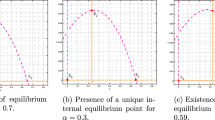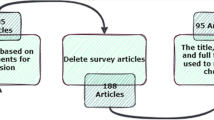Abstract
The study of this work is to present the analytical solutions of prey-predator model by using the artificial neural networks (ANN). We studied the dynamics of a food web model consisting of one prey and two predators. We discussed the positivity, boundedness and well posedness of the system. The model was expressed in the form of an input, hidden layer and output, flow chart and ANN methods. We obtained the solutions of ANN simulations by using Mathematica programming. We analyzed the physical and geometrical interpretation of the solutions. Here, we found that preypredators population exist at the beginning phase, whereas the population of prey and middle spice predator decrease with respect to time. We further found that top predator population increases due to the availability of the food.






Similar content being viewed by others
Data Availability
All data analyzed during the study are included in this article.
References
M. Umar, Z. Sabir, M.A.Z. Raja, Intelligent computing for numerical treatment of nonlinear prey-predator models. Appl. Soft Comput. 80, 506–524 (2019)
N. Ruttanaprommarin et al., Supervised neural learning for the predator-prey delay differential system of Holling form-III. AIMS Mathematics 7(11), 20126–20142 (2022)
T.T. Dufera, Deep neural network for system of ordinary differential equations: Vectorized algorithm and simulation. Mach. Learn. App. 5, 100058 (2021)
N. Yadav et al., An introduction to neural network methods for differential equations. Springer (2015)
I. Basheer, M. Hajmeer, Artificial neural networks: Fundamentals, computing, design, and application. J. Microbiol. Methods 43(1), 3–31 (2000)
J. Schmidhuber, Deep learning in neural networks: an overview. Neural Netw. 61, 85–117 (2015)
N. Yoshida, From retina to behavior: prey-predator recognition by convolutional neural networks and their modulation by classical conditioning. Sage J. 24 (4) 2016
Botmart et al., Artificial neural network-based heuristic to solve COVID-19 model including government strategies and individual responses. Inf. Med. Unlocked 32, 101028 (2022)
S. Chakraverty, S. Mall, Artificial neural networks for engineers and scientists: Solving ordinary differential equations. CRC Press (2017)
H. Lee, I.S. Kang, Neural algorithm for solving differential equations. J. Comput. Phys. 91, 110–131 (1990)
Chen et al., A python package for solving differential equations with neural networks. J. Open Source Software 5(46), 1931 (2020)
Abadi et al. Tensorflow: A system for large-scale machine learning. 12th USENIX symposium on operating systems design and implementation, Savanah, GA, USA, 265–283, 2016.
H.A. Ibrahim, R.K. Naji, Complex dynamics in three species food web model Involving Stage Structure and Cannibalism, AIP Conference Proceedings. https://doi.org/10.1063/5.0030510 (2020)
R.K. Naji, H.F. Ridha, The dynamics of four species food web model with stage structure, Int. J. Tech. Enhanc. Emerging Engg. Res. 4(3), (2016)
M.E. Gurtin, D.S. Levine, On populations that cannibalize their young. SIAM J. Appl. Math. 42, 94–108 (1982)
O. Diekmann, R.M. Nisbet, W.C.S. Gurney, F.V. Bosch, Simple mathematical models for cannibalism: a critique and a new approach. Math. Biosci. 78, 21–46 (1986)
J. Bhattacharyya, S. Pal., Coexistence of competing predators in a coral reef ecosystem. Nonlinear Anal. Real World Appl., 12, 965–978 (2011)
S. Hsu, S. Ruan, T. Yang, Analysis of three species Lotka-Volterra food web models with omnivory. J. Math. Anal. Appl. 426, 659–687 (2015)
Acknowledgements
The authors express their sincere thanks and gratitude to the reviewer for their suggestions toward the improvement of the paper.
Author information
Authors and Affiliations
Corresponding author
Ethics declarations
Conflict of interest
The authors declare that there is no conflict regarding the publication of this article.
Ethical approval
The authors state that this research complies with ethical standards. This research does not involve either human participants or animals.
Rights and permissions
Springer Nature or its licensor (e.g. a society or other partner) holds exclusive rights to this article under a publishing agreement with the author(s) or other rightsholder(s); author self-archiving of the accepted manuscript version of this article is solely governed by the terms of such publishing agreement and applicable law.
About this article
Cite this article
Chanyalew, B., Sahu, S.K. & Ayele, E.T. Artificial neural networks for the food web model. Eur. Phys. J. Plus 139, 367 (2024). https://doi.org/10.1140/epjp/s13360-024-05107-0
Received:
Accepted:
Published:
DOI: https://doi.org/10.1140/epjp/s13360-024-05107-0




